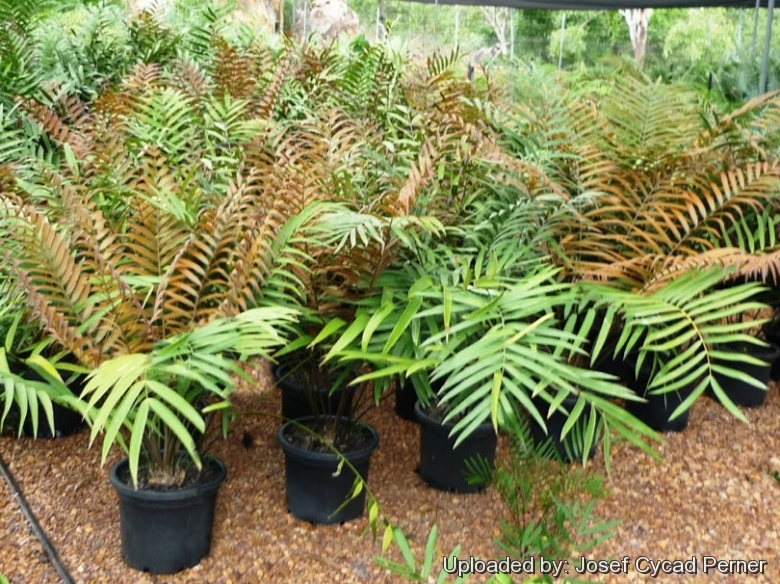
Ceratozamia latifolia Photo by: Josef Cycad Perner
New bronze emergent leaves at Cycad International, Katherine, Northern Territory, Australia.
Origin and Habitat: Ceratozamia latifoliaSN|30188]]SN|30188]] is indigenous to central Mexico, in the Querataro, Hidalgo and San Luis Potosí states (near Xilitla and Tamazunchale)
Habitat and Ecology: This species is restricted to subtropical or tropical moist lowland oak forests in the cloud zone of the Sierra Madre Oriental, on steep limestone hillsides and canyons. It is often associated with limestone karst formations and densities may increase near cave entrances (possibly due to concentrations of seed dispersers). This species has been affected by habitat destruction as a result of clearance for banana and coffee plantations. Many hundreds of specimens have been collected in the past for ornamental purposes.
Synonyms:
See all synonyms of Ceratozamia latifolia
back
Accepted name in llifle Database:Ceratozamia latifolia Miq.Tijdschr. Wis- Natuurk. Wetensch. Eerste Kl. Kon. Ned. Inst. Wetensch. 1: 206 (1848)Synonymy: 3
back
Description: Ceratozamia latifoliaSN|30174]]SN|30188]] has a short, round stem that is mostly underground. Its leaves are up to 1.5 m long with prickly petioles and narrowish lancelote slightly cupped leatherly dark green leaflets. There are variations of this species, but most have beautiful red emergent leaves. This plant has spreading habit, but rare to sucker and will eventually attain a 2.10 m spread.
Distinguishing features: Ceratozamia latifoliaSN|30188]]SN|30188]] has thick, concave and relatively narrow leaflets with attenuate, symmetrical tips and broad bases and not falcate. Juvenile specimens are quite similar to young Ceratozamia mexicanaSN|30188]]SN|30174]] and the two plants are not readily distinguishable st this stage.
Stem: Up to 50 cm long (aboveground part rarely exceeding 15 cm), 15-20 cm in diameter.
Leaves: 2-20 in crown. New growth emerging bronze-red or mid-green, becoming bright or dark green, semiglossy, 100-150 cm long, flat (not keeled) in section, with 50-150 leaflets. Venation straight and no distinct midrib. Rachis not or slightly spirally twisted. Petiole 20-50 cm long, armed with prickles.
Leaflets not clustered, lanceolate, symmetric, broadest below middle, falcate, concolorous, thick, chartaceous to papyraceous or leathery; margins flat; median leaflets 20-30 cm long, 15-40(-50) mm wide.
Pollen cones: Brown, ovoid-cylindrical, 20-30 cm long, 10-12 cm diam.; peduncle 10 cm long; 10 mm wide.
Seed cones: Grey, ovoid-cylindrical, 20-35 cm long, 10-12 cm diam.; peduncle 12 cm long.
Seeds: Ovoid, 20 mm long, 18 mm wide; sarcotesta white, ageing to brown.
Bibliography: Major references and further lectures
1) Vovides, A. Chemnick, J. & Gregory, T. 2010. Ceratozamia latifolia. The IUCN Red List of Threatened Species. Version 2014.3. <www.iucnredlist.org>. Downloaded on 16 January 2015.
2) V.P. Singh “Australia and Its Geography” Sarup & Sons, 2010
3) Keith Boyer “Palms and Cycads Beyond the Tropics: A Guide to Growing Cold-hardy” Publication Fund, Palm & Cycad Societies of Australia, 1992
4) “Proceedings of the ... Annual Meeting of the Florida State Horticultural Society” Volume 113 Florida State Horticultural Society. Meeting The Society, 2000
5) Wikipedia contributors. "Ceratozamia latifolia." Wikipedia, The Free Encyclopedia. Wikipedia, The Free Encyclopedia, 17 Mar. 2013. Web. 16 Jan. 2015.
6) Ken Hill: 1998-2010 "Ceratozamia mexicana" – In The Cycad Pages. <http://plantnet.rbgsyd.nsw.gov.au/PlantNet/cycad/> Downloaded on 15 Jan. 2015.
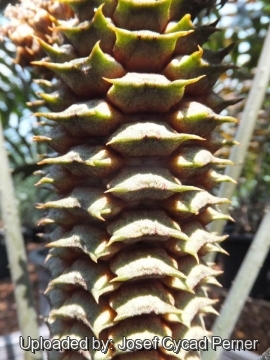 Cycad Cones in Joe's Cycad Gardens. Receptive female cone. Photo by: Josef Cycad Perner
Cycad Cones in Joe's Cycad Gardens. Receptive female cone. Photo by: Josef Cycad Perner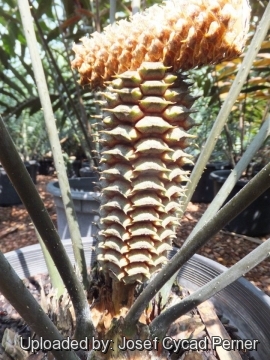 Receptive female cone being pollinated with a mature male cone which is dehiscing pollen. Photo by: Josef Cycad Perner
Receptive female cone being pollinated with a mature male cone which is dehiscing pollen. Photo by: Josef Cycad Perner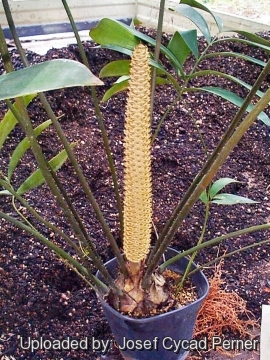 Male cone. Photo by: Josef Cycad Perner
Male cone. Photo by: Josef Cycad Perner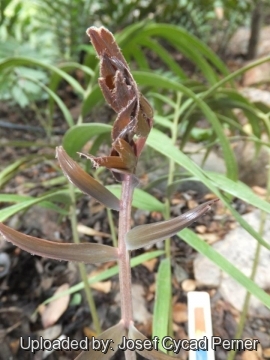 Bronze emergent leaves. Photo by: Josef Cycad Perner
Bronze emergent leaves. Photo by: Josef Cycad Perner Ceratozamia latifolia Photo by: Josef Cycad Perner
Ceratozamia latifolia Photo by: Josef Cycad Perner Ceratozamia latifolia Photo by: Josef Cycad Perner
Ceratozamia latifolia Photo by: Josef Cycad Perner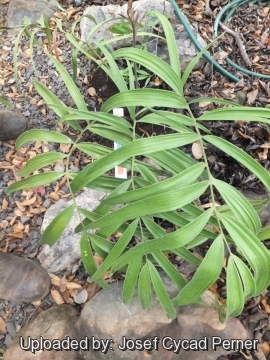 Ceratozamia latifolia Photo by: Josef Cycad Perner
Ceratozamia latifolia Photo by: Josef Cycad PernerSend a photo of this plant.The gallery now contains thousands of pictures, however it is possible to do even more. We are, of course, seeking photos of species not yet shown in the gallery but not only that, we are also looking for better pictures than those already present.
Read More... Cultivation and Propagation: Ceratozamia latifoliaSN|30188]]SN|30188]] is a palm-or fern-like plant with long pinnate, arching fronds, with new growth emerging pinkish or coppery green. It's a beauty and one of the best landscape plants in the genus. It prefers to be in the shade to look its best. It has proven to be very cold and frost hardy. It grows fairly fast and reacts well to fertilizer applications. Not common in cultivation but available at specialty nurseries.
Exposition: It prefers bright light exposure but colour bleaches when in full sun; best with some protection from afternoon heat but not in constant deep shade.
Soil: Needs a neutral, well drained sandy soil spot, with deep soil, but will still thrive in less than ideal conditions. Mulch with organic materials (bark or leaf mould).
Moisture: Water when dry. Drought tolerant.
Fertilization. Because of its growth habit, fertilize only when terminal bud begins to swell, indicating the start of the annual growth cycle.
Hardiness: It should be protected from extreme cold, but it is much hardier than you might think. (USDA Zones 8a.-11) Sustains leaf damage at -5° C.
Maintenance: Minimal; removal of offsets if desired, removal of spent fronds
Use: Landscape as cultivated perennial in warm areas, it makes a great accent or specimen plant. Several can be planted together for a lush, tropical effect. Plant on three to five-foot-centers to create a mass planting. Use near the patio, in mixed foundation plantings or in perennial beds. It is a spectacular house-plant or interior-scape specimen in cool areas tough enough to survive occasional neglect and harsh indoor environments.
Warning: All parts of the plant are poisonous to animals and humans. The toxicity causes liver and kidney failure, as well as eventual paralysis. Dehydration sets in very quickly. No treatment for the poisoning is currently known. Poisonous Parts: Fleshy seeds, leaves. Protect pets and instruct children to never eat or chew any plant material without permission.
Propagation: Seeds. The germination process is very slow and difficult to achieve in cultivation, after fertile seeds are collected, they usually need several months of storage before the inner embryo is ready to germinate. Therefore, it is best to clean the seeds of external fruit and set them aside before attempting to propagate the seeds. Seeds should be sown in shallow container, lightly covered with sand, and after germination, potted off in small pots of moderately rich, light soil. The growing plants do best in partial shade. The old plants occasionally send up suckers around the base of the trunk. These may be taken off when in a dormant state and rooted, care being taken to remove the leaves to guard against excessive transpiration. The advantage of the "pups" is that you will know its sex, for seedlings you will have to wait several years until the plant flowers to find out.
















